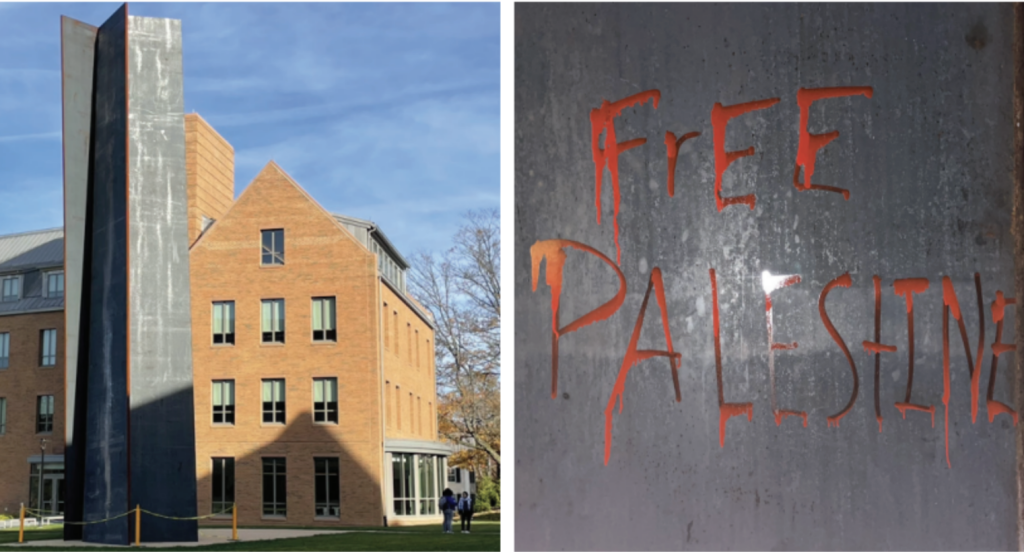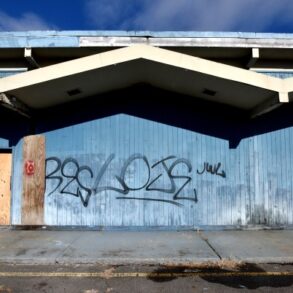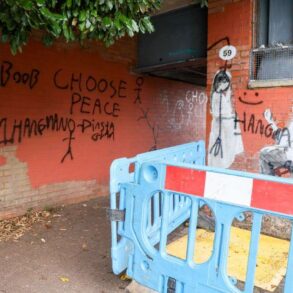
College officials discovered the graffiti prior to the Board meeting. | DAISY NEWBURY
On Oct. 24, just after 11 a.m., College officials discovered graffiti calling for divestment and support for Palestine on the Richard Serra sculpture in the West Quad. Three phrases were written on the interior of the structure using red spray paint: “F— The Board,” “FREE PALESTINE” and “Divest NOW.”
Pivot by Richard Serra was installed on campus in June 2020 following a donation from Graham Gund ’63 H’81 and his wife, Ann Gund. As of Wednesday, the graffiti has not been removed; however, it has been covered temporarily with black cardstock and magnets.
According to Gund Director and Chief Curator Daisy Desrosiers, former MoMA Sculpture and Objects Conservator Roger Griffith will supervise the development of a tailored restoration plan following an initial assessment of the damage this weekend. This plan may include cleaning vandalized areas and repairing physical damage to the weathering steel, likely with specific care taken to maintain the material’s natural patina. Any restoration will be documented to maintain a historical record of the work done.
The restoration timeline is dependent on how extensively the markings have penetrated the sculpture’s surfaces. Desrosiers hopes for treatment to be complete by the end of the weekend. “Works like Pivot may feel like easy targets precisely because they are prominent; they stand out,” Desrosiers wrote in an email to the Collegian. “Moving forward, let us ask ourselves how to better foster a culture of mindfulness and mutual respect on our campus, recognizing our collective responsibility to preserve these assets for all. In doing so, we uphold the value of the art itself and the principles of open engagement and civic responsibility that define us as a learning community.”
The vandalization happened on Founders’ Day, the College’s annual commemoration of the professors, benefactors, alumni and students who have contributed to Kenyon’s community. This year’s ceremony was held in Rosse Hall at 11:10 a.m., which was approximately when the vandalism was discovered, according to Director of Campus Safety Michael Sweazey. That afternoon, President Julie Kornfeld condemned the vandalization in an email sent to students and employees just after 4:30 p.m.
“While Kenyon respects the right of all members of the community to peacefully protest for any lawful reason, this does not include actions that damage Kenyon property, deprive others from participating fully in campus activities, or otherwise put people’s health or safety at risk,” Kornfeld wrote. “I am deeply disheartened by this action and it does not align with the community values I have seen in place since my arrival at Kenyon.”
Founders’ Day also marked the first day of meetings for the Board of Trustees, which met at 5:30 p.m. in Chalmers Library. Kenyon Students for Justice in Palestine (KSJP) held a sit-in during the event on the Chalmers lawn to demand that Kenyon divest from weapon manufacturers.
In her email, Kornfeld explained that, last spring, she asked the Board’s Investment Committee to review Kenyon’s policies and practices for socially responsible investing, as well as to propose new guidelines regarding community input. According to an Oct. 22 Instagram post advertising the sit-in, KSJP stated that the Board “[has] been delaying the process of disclosing and divesting from weapon manufacturing.”
KSJP stated in an email to the community that it does not condone the destruction of Kenyon property. “Not only does this action break school policy, but it disparages our cause,” the email read. “Our goal has been, and still is, to maximize student input on Kenyon’s investment policies. Disregard for school policy in advocating for Palestine hurts our cause and works directly against the peaceful action we have been planning for today.”
According to Sweazey, both the College and local law enforcement are conducting investigations of the incident. “While Kenyon is obviously cooperating with law enforcement, it should be noted that they are two separate and distinct processes,” Sweazey wrote in an email to the Collegian. “As President Kornfeld’s message made clear, this is an act of vandalism against a valuable piece of donated artwork that the College and The Gund Gallery are taking very seriously.”
Sweazey also noted that the College has information regarding who committed the vandalism. “I’m not at liberty to speak about the specifics of the investigation, but we do have information regarding the suspected identity(ies) of person(s) involved in the vandalism,” he wrote. Further reiterating what Kornfeld said in her email, Sweazey encouraged those with information about the vandalism to reach out to the Office of Student Rights and Responsibilities, the Office of Campus Safety or the Office for Civil Rights, all of which offer anonymous reporting options.
“I highly encourage anyone involved in the vandalism to contact us. They may contact me directly, if they like, and we will take care of this and put it behind us,” Sweazey said. “Just like in the television shows, cooperation can go a long way to improving outcomes.”
This post was originally published on this site be sure to check out more of their content.







